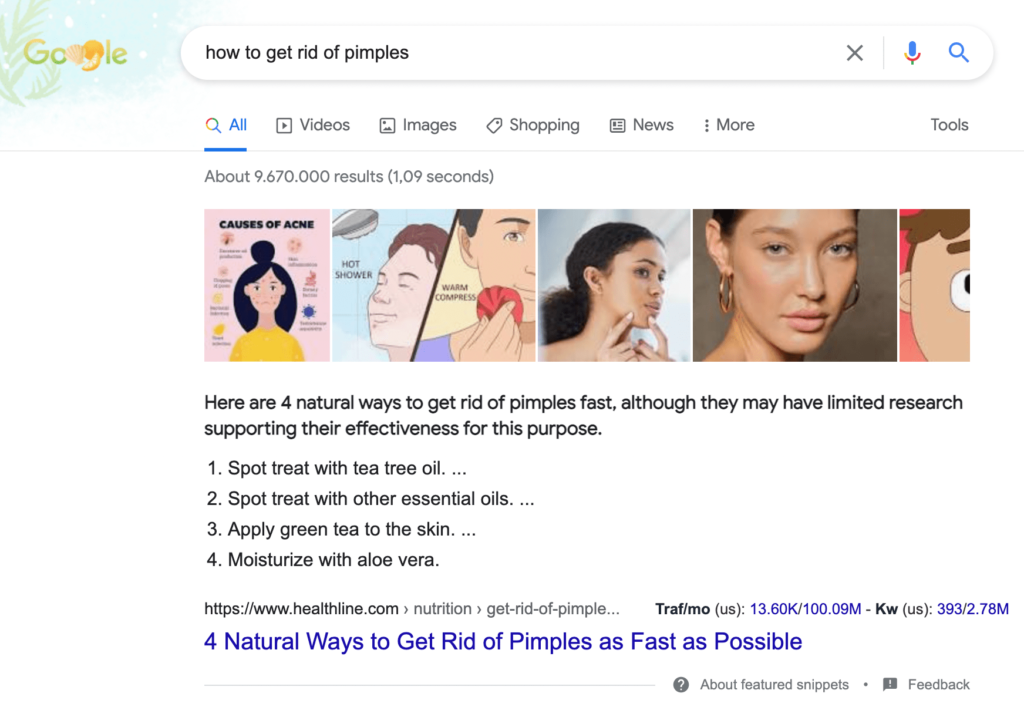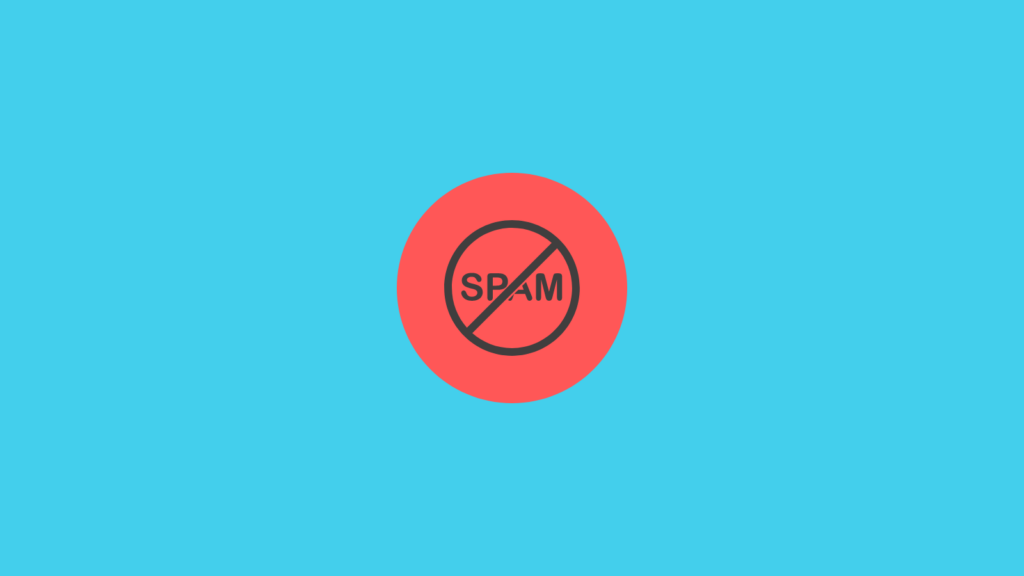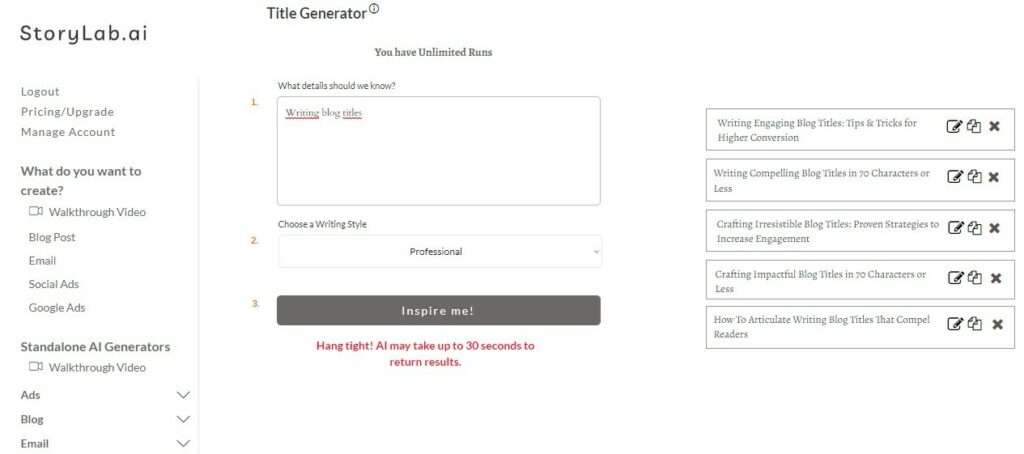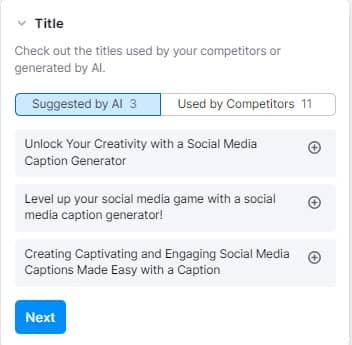How To Write Great Blog Post Titles in 2024 [AI Tools Included]
Do you want to attract more readers? Your Blog Post Titles can make or break your Content Marketing Efforts. Here’s how to Write Great Headlines and how AI can help.

Multiple pieces of research show that having a great Blog Post Title can increase your traffic by hundreds of percentages. Some even state 500%+.
When you’re scrolling through your Social Media feed, what makes you stop reading (or click through and read)? The image and the title, right?
When you’re searching for something in a Search Engine, what makes you click on a search result? The ranking and title, right?
Great Blog Post Titles matter a lot when it comes to attracting the attention of people.
Let’s go over how to write great Blog Post Titles and we’ll provide you with a Template and a couple of AI Tools to become even more effective.
First this: Grow faster than ever before!
Seamlessly blend creativity and technology. See how you can start with AI Marketing and reach your goals faster than ever before. Check out the Tips, Strategies, AI Tools, Masterclass, Courses, and Community. Unleash the true potential of your brand with the help of AI.
In this article
- How to Write Great Blog Post Headlines
- 1. Create Great Content
- 2. Understand your Readers. SERP and Key Word Research
- 3. Use Numbers and Power Words in your Titles
- 4. Don’t be spammy / Don’t oversell
- 5. How to Write SEO Friendly Blog Titles
- 6. Practice: Write multiple blog headlines and pick the best one
- Blog Title Examples and Template
- The Best AI-Powered Blog Title Generators
- AI Blog Title Generator by StoryLab.ai
- Benefits the AI-Powered Blog Title Generator
- AI Blog Title Generator by Semrush (ContentShake)
- How to Write Great Blog Titles with AI
- The Future of AI Blog Title Generators
- FAQ
- More AI Tools
How to Write Great Blog Post Headlines

1. Create Great Content
To be able to write great Blog Post Headlines, you will also need great content.
What do we mean by that?
Let’s take this article as an example. Depending on the number of hours we want to invest in this piece of content, the title can change from:
- 3 Tips For Writing Great Blog Post Headlines And Increase Your Traffic.
- 15 Tips For Writing Great Blog Post Headlines And Increase Your Traffic.
- 15 Tips For Writing Great Blog Post Headlines [Template included].
- How To Create Great Blog Post Titles [Tips, Template & Tools].
If you create surface-level content that does not help people with all questions they might have about a subject, you can’t promise them a lot of value.
You’ll already be 2 steps behind others that do invest the time to create a solid piece of content.
When possible, add more value to your Blog Post (and thus Headline) with assets like:
- Video;
- Research;
- Template;
- Tool;
- Infographic;
- Full guide.
- Etc.
2. Understand your Readers. SERP and Key Word Research

Understanding your readers might be a no-brainer, but this is very important.
Are your readers trying to:
- Grow;
- Learn;
- Achieve something fast;
- Watch a video;
- Compare products;
- Etc.
For example:
You’re planning to write an article about ‘how to get rid of pimples’.
Your best bet is to write an article and headline including ‘Fast’.
How do I know?
A simple Google Search Query shows that all top-ranking articles are about ‘How to get rid of pimples fast’ (see image below).

As you can see. A quick Google search can help you find out which problem people are trying to solve.
You can take it a step further by doing proper SEO Key Word research and finding out which words people usually use.
Did you know that people search for ‘Digital Marketing’ more often than for ‘Online Marketing’ and for ‘Sups’ more often than for ‘Supplements’.
Do your research and speak your reader’s language.
3. Use Numbers and Power Words in your Titles

Using numbers has been proven to help increase click-through rates. Odd numbers often work better than even numbers and the number 7 seems to be pretty special.
This is a pretty simple tip to include whenever appropriate.
Next to numbers and content assets we discussed in our first tip, there are power words that you can include. Here’s a shortlist, be sure to create your own depending on your goals and the industry you’re in.
List of Power Words to Include in your Blog Post Title
- You
- Memorable
- Latest
- Surprising
- Cheat-Sheet
- Easy
- Step-by-Step
- Tricks
- Beautiful
- Bold
- Kickstart
- Avoid
- Struggle
- Practical
- Master
- Free
- Immediately
- Never
- Definitive
- Untapped
- Little-Known
- Fail-Proof
4. Don’t be spammy / Don’t oversell

It might be tempting to fill your Blog Title with 10 Power Words and call it a day.
You might remember that Buzz Feed used to heavily oversell with their Blog Titles.
Over the years, we even needed to invent the word ‘Click Bait‘ for spammy Titles.
Don’t go that route.
People will unfollow you on Social Media and your SEO rankings will drop!
One thing that Search Engines hate is ‘Pogo Sticking‘. Meaning, a searcher clicks on a search result, does not find what the expected, goes back to the search engine, clicks on the next result.
5. How to Write SEO Friendly Blog Titles

Your Blog Post Title, Meta Title Tag (for Search Engines) and Social Media Title (O.G. / Open Graph) can all differ from each other.
To be honest…
At GlobalOwls we just stick with one Title and make sure it’s good enough for all three with the focus on SEO.
But that’s just because we focus most on SEO. That can differ for you.
So, how do you write SEO Friendly Blog Titles?
- Do your keyword research;
- Do your SERP research (as discussed in a previous step);
- Select one keyword (combination) you want to rank for;
- Make sure that keyword is as much as you can at the start of the title;
- Write a great headline that makes people want to click your search result;
- Make sure the Title is not longer than 60 characters or 575 pixels.
No. It’s not too complicated 🙂
But it does help to follow the checklist when writing SEO-optimized blog titles.
6. Practice: Write multiple blog headlines and pick the best one
You might have heard that some journalists and content writers spend as much time on writing the article as they do on writing multiple headlines and selecting the best one.
I combined these two tips because they work so well together.
You need to practice to become better at writing great blog headlines and you need to write a couple of headlines per article to be able to select the best one.
It would be a shame if you would spend 10 hours creating a great piece of content and just 1 minute on writing your headline.
Your content deserves better.
Blog Title Examples and Template

Ok. Now you have some tips for writing great blog titles.
These will come in handy when personalizing your headlines.
We will now show you a couple of great Blog Title Examples, then provide you with Templates and then share with you a couple of Blog Title Generators.
A couple of Great Blog Title Examples with Templates
What 7 Professionals Say About Writing Blog Post Titles
What [Number of] Professionals / Studies Say About [Key Word]
11 Blog Post Titles That Are Proven To Increase Your Click-Through Rates
[Number of] [Key Word] That Are Proven To [Desirable Outcome]
7 Ways To Be Productive When You Are Working From Home
[Number of] Ways To Be [Power Word] When You Are [Key Word]
How To Write Blog Post Titles With The Best Tools
How To [Key Word] With The Best [Subject]
How To Prepare Your Business For Massive Growth
How To [Verb] Your [Noun] For Massive Growth
The Best AI-Powered Blog Title Generators

We find the tips above to be invaluable, the templates to be ok and the following AI Powered Blog Title Generators to be of great help.
Be sure to check them out but be sure to create great content, personalize your headlines, and don’t skip the essential steps just because you’re using an AI Blog Title generator.
AI Blog Title Generator by StoryLab.ai
If you’re looking to create a ton of highly relevant blog title suggestions, check out StoryLab.ai’s AI Blog Title Generator.
Their AI generator is based on GPT-3’s powerful Natural Language Processing tool. Simply insert a description of what you would like to write about and you’ll get a ton of valuable ideas.
If you chose to do so, you can even take it one or two steps further by selecting the blog title you like most and let StoryLab.ai suggest intros and blog outlines.
Check it out. StoryLab.ai comes with a free trial.
Get started with StoryLab.ai’s Blog Title Generator.
Here´s what it looks like. Let’s say I want to create a title for this article. All I need to do is insert ‘write blog title’ and here’s what the AI came up with:

AI Blog Title Generator outputs:
- Writing Engaging Blog Titles: Tips & Tricks for Higher Conversion
- Writing Compelling Blog Titles in 70 Characters or Less
- Crafting Irresistible Blog Titles: Proven Strategies to Increase Engagement
- Crafting Impactful Blog Titles in 70 Characters or Less
- How To Articulate Writing Blog Titles That Compel Readers
I decided to run the Blog Title Maker again and here’s the second batch of headline examples:
- Crafting a Captivating Blog Title With Impact
- Writing Compelling Blog Titles in 70 Characters or Less
- Write Better Blog Titles to Boost Traffic and Engagement
- Creating Catchy Blog Titles for Maximum Engagement
- Creating Catchy Blog Titles that Drive Engagement
And here’s the third batch of potential headlines:
- Crafting Compelling Blog Titles: How to Win Over Readers in 70 Characters or Less
- Creating Compelling Blog Titles in Less Than 70 Characters
- Write More Compelling Blog Titles in 70 Characters or Less
- Writing Compelling Blog Titles: Tips and Tricks
- Professional Writing Tips for Crafting Compelling Blog Titles
I’ve just created 15 inspirational pieces for my blog post title. I can now select the best one, add my unique human touch and voice and perfect it.
Benefits the AI-Powered Blog Title Generator
At a glance, here’s what the Blog Title Generator can do for you.
| 🤖AI modes | 13 writing styles |
 Improves Improves |
blog content, creativity, and more |
| 🦾Supports | 17+ Languages |
 Price Price |
Free and Premium |
AI Blog Title Generator by Semrush (ContentShake)
Semrush is a Keyword research tool and they´ve created ContentShake to go from insights (keyword research) to content ideas and to full-written articles in minutes. ContentShake comes with a free trial so you can see if you like this AI Blog Title Generator better than other AI tools and select the one that fits your content creation processes best. Be sure to try it out and see if you love it.
Here’s what their AI Blog Title Generator insights look like. They give you 3 suggestions for your article and show the titles your competitors are using for that given keyword.


How to Write Great Blog Titles with AI
Step 1: Embrace AI-Powered Title Generators
Embrace the power of AI to create captivating blog titles! Look for reputable AI-powered title generators that analyze your content and suggest relevant, attention-grabbing titles.
Step 2: Understand Your Blog Content
Before generating titles, thoroughly understand your blog’s content, main points, and target audience. This knowledge will help the AI generate more relevant and compelling titles.
Step 3: Generate AI-Powered Titles
Input your blog’s key points and keywords into the AI-powered generator. Let the magic happen as the AI crafts a variety of engaging titles based on your content.
Step 4: Review and Customize
Review the AI-generated titles and choose the ones that resonate most with your blog’s message and style. Customize the titles to add your unique voice and personality.
Step 5: Utilize Numbers and Questions
AI often suggests using numbers and questions in titles, as they pique curiosity and encourage clicks. Incorporate these elements to make your titles irresistible.
Step 6: Optimize for SEO
AI understands SEO! Integrate relevant keywords into your titles to improve search engine visibility and attract organic traffic to your blog.
Step 7: Aim for Clarity and Conciseness
Ensure your titles are clear and concise, conveying the essence of your blog’s content in a few words. Avoid being too vague or lengthy, as concise titles are more effective.
Step 8: Test and Analyze
Publish your blog with the AI-generated title and analyze its performance. Monitor metrics like click-through rate, time on page, and bounce rate. Use this data to refine your title strategies and improve future titles.
Step 9: Experiment with Variations
Try different AI-generated titles for the same blog post and A/B test them to see which performs best. Experimentation can reveal insights into what resonates most with your audience.
Step 10: Stay Human-Centric
While AI can suggest great titles, remember that your blog’s voice and authenticity come from you. Infuse your personality and expertise into the content, making it uniquely yours.
By following this step-by-step guide, you can harness the power of AI to craft blog titles that engage readers, improve SEO, and attract more visitors to your blog. Embrace AI technology and watch your blog soar to new heights of success!
The Future of AI Blog Title Generators

The future of AI blog title generators looks promising, with advancements in AI and natural language processing (NLP) poised to make these tools more effective, efficient, and versatile. Here are some key trends and potential developments in this area:
1. Enhanced Creativity and Originality
Advanced Algorithms:
- Future AI blog title generators will leverage more sophisticated algorithms to produce highly creative and original titles, avoiding common clichés and overly generic suggestions.
Deep Learning Models:
- Utilizing deep learning models, such as GPT-4 and beyond, these tools will generate titles that are not only catchy but also contextually relevant and engaging.
2. Personalization and Context Awareness
User Preferences:
- AI tools will become better at learning individual user preferences, tailoring title suggestions to match the style and tone that align with specific blogs or audiences.
Content Context:
- By analyzing the content of the blog post, AI generators will provide titles that accurately reflect the post’s main ideas and themes, improving relevance and click-through rates.
3. SEO Optimization
Keyword Integration:
- Future tools will seamlessly integrate SEO best practices, suggesting titles that include relevant keywords without compromising on readability or appeal.
Trend Analysis:
- AI will analyze trending topics and popular search queries in real-time, offering title suggestions that capitalize on current trends and user interests.
4. Multilingual and Cultural Sensitivity
Language Support:
- Enhanced support for multiple languages will allow content creators to generate optimized titles for diverse audiences across the globe.
Cultural Nuances:
- AI will become more adept at understanding and incorporating cultural nuances, ensuring that titles are appropriate and engaging for various cultural contexts.
5. Integration with Content Management Systems (CMS)
Seamless Integration:
- AI blog title generators will integrate more seamlessly with popular CMS platforms like WordPress, Wix, and Squarespace, allowing users to generate and insert titles directly from their content creation interface.
Real-Time Suggestions:
- As users write their posts, real-time title suggestions will be provided, allowing for immediate refinement and optimization.
6. Data-Driven Insights
Performance Analytics:
- Future tools will offer analytics on title performance, providing insights into which types of titles drive the most engagement, allowing for data-driven adjustments and improvements.
A/B Testing:
- Built-in A/B testing capabilities will let users test different titles to see which one performs better, helping to refine title strategies over time.
7. Enhanced User Experience
User-Friendly Interfaces:
- Improved interfaces will make it easier for users to generate and select the best titles, with intuitive design and user-friendly controls.
Customization Options:
- Users will have more control over the customization of titles, including the ability to set parameters like tone, length, and style preferences.
8. Collaboration and Integration with Other AI Tools
Content Creation Suites:
- AI blog title generators will be part of larger AI-powered content creation suites, working in tandem with tools for writing, editing, and publishing.
Voice and Text Input:
- Users will be able to input content and receive title suggestions through both voice and text commands, enhancing flexibility and convenience.
9. Ethical Considerations and Bias Mitigation
Bias Detection:
- Future AI models will include advanced mechanisms for detecting and mitigating biases, ensuring that title suggestions are fair, inclusive, and free from harmful stereotypes.
Transparency and Control:
- Greater transparency in how AI generates suggestions and more user control over the process will enhance trust and ethical use.
Conclusion
The future of AI blog title generators is bright, with significant improvements in creativity, personalization, SEO optimization, and user experience on the horizon. As these tools become more advanced, they will not only help content creators craft compelling titles but also drive greater engagement and success for blogs across various industries. By leveraging these advancements, bloggers and marketers can stay ahead of the curve, continuously improving their content strategies and reaching wider audiences.
We hope this article was helpful for you to Write Great Blog Post Titles and to understand how AI can help.
FAQ
What Are Key Elements of a Captivating Blog Post Title?
A captivating blog post title should be clear, concise, and engaging. It needs to accurately reflect the content of the post, use relevant keywords for SEO, and be intriguing enough to draw readers in.
How Important Are Keywords in Blog Post Titles?
Keywords are crucial in blog post titles for SEO purposes. They help search engines understand the topic of your post and improve its visibility in search results, but they should be used naturally and not overdone.
What Length Is Ideal for a Blog Post Title?
The ideal length for a blog post title is typically between 6 to 10 words. This length is enough to convey the topic clearly while keeping it short enough for easy readability and SEO optimization.
Should Blog Post Titles Pose a Question?
Posing a question in a blog post title can be effective as it engages the reader’s curiosity and encourages them to seek the answer by reading the post. However, this approach should align with the content and tone of the article.
Can Using Numbers in Blog Post Titles Increase Engagement?
Yes, using numbers can increase engagement as it sets clear expectations for the reader (like “5 Tips for…”). Listicles are often more appealing because they promise quick, structured information.
How Do You Balance Creativity and Clarity in Titles?
Balancing creativity and clarity involves being unique and catchy without sacrificing the title’s directness. The title should spark interest while still being clear about the content of the post.
Is It Effective to Use Power Words in Blog Post Titles?
Using power words – words that trigger emotional or psychological responses – can make titles more compelling. However, they should be relevant to the content and not just clickbait.
Should Blog Post Titles Be Optimized for Social Media Sharing?
Yes, optimizing titles for social media sharing involves making them engaging and share-worthy. Consider how the title will look in social media posts and if it encourages sharing.
How Do Trending Topics Influence Blog Post Titles?
Incorporating trending topics into blog post titles can increase relevance and immediacy, attracting more readers. However, ensure the content is genuinely connected to the trend and provides value.
What’s the Impact of Tone and Voice in Blog Titles?
The tone and voice in blog titles should align with your overall brand voice. A consistent tone helps in building a connection with your audience and makes your content easily recognizable.
Should You Update Blog Post Titles Over Time?
Updating blog post titles can be beneficial, especially for SEO purposes or to keep the content relevant. This is particularly true for posts covering topics that evolve over time.
How Does Audience Demographic Affect Title Choices?
Audience demographic (age, location, interests) significantly influences how you frame your titles. Titles should speak directly to the specific interests and needs of your target audience.
Is It Advisable to Use Humor in Blog Post Titles?
Using humor in blog post titles can be effective if it suits your brand and audience. It can make titles more memorable and engaging but be cautious not to alienate or confuse your readers.
What Is the Role of Urgency in Blog Post Titles?
Creating a sense of urgency in blog post titles can prompt immediate reader engagement. Phrases like “Don’t Miss Out” or “Limited Time” can create a sense of urgency but should be used appropriately.
How Can You Reflect Brand Identity in Blog Post Titles?
Reflecting your brand identity in blog post titles involves using language and themes consistent with your brand’s values and messaging. This strengthens brand recognition and loyalty.
What Are the Risks of Misleading or Clickbait Titles?
Misleading or clickbait titles may initially attract readers, but they can harm credibility and reader trust. They also negatively impact SEO if the content doesn’t match the title’s promise.
How Can Cultural Sensitivity Be Incorporated in Titles?
Being culturally sensitive in titles means avoiding stereotypes, generalizations, and language that could be offensive. Understanding and respecting cultural nuances helps in creating inclusive content.
What’s the Importance of Testing Different Title Formats?
Testing different title formats (like questions, how-to, listicles) allows you to understand what resonates best with your audience. Analyzing engagement metrics helps in refining your approach to title creation.
How Can You Test the Effectiveness of a Blog Post Title?
You can test the effectiveness of a blog post title by A/B testing different titles and analyzing metrics like click-through rates, social shares, and engagement levels.
What Role Does Audience Understanding Play in Title Creation?
Understanding your audience is key in creating effective titles. Knowing their interests, pain points, and language style helps in crafting titles that resonate and attract their attention.
Can Localizing Blog Post Titles Increase Engagement?
Localizing titles by including specific geographic locations or local references can increase engagement among targeted regional audiences, making the content more relevant to their specific interests.
How Can You Incorporate Storytelling Elements into Titles?
Incorporating storytelling elements, like a hint of a narrative or a teaser of a story, can make titles more intriguing and encourage readers to engage with the content to discover the full story.
What’s the Benefit of Using Specificity in Blog Post Titles?
Using specificity in titles by providing detailed descriptions or exact figures can increase credibility and appeal, as it sets clear expectations for the reader about the content’s depth and focus.
How Do You Balance SEO and Reader Engagement in Titles?
Balancing SEO and reader engagement involves using keywords strategically while also ensuring the title is interesting and engaging to the reader. Overuse of keywords can make a title sound robotic and unappealing.
Is It Effective to Use Questions as Blog Post Titles?
Using questions as blog post titles can be effective as it directly engages the reader’s curiosity and prompts them to seek answers, making them more likely to read the article.
What Role Does Feedback Play in Crafting Blog Post Titles?
Feedback from readers can provide valuable insights into what types of titles resonate most. Analyzing comments, shares, and engagement can guide adjustments to title crafting strategies.
How Important Is Consistency in Blog Post Title Styles?
Consistency in title styles helps in building a recognizable brand voice. However, there should still be enough variation to keep titles fresh and interesting for returning readers.
What’s the Impact of Negative or Controversial Titles?
Negative or controversial titles can attract attention, but they may also deter certain readers or provoke unintended reactions. They should be used judiciously and with consideration of the potential impact.
Can Including Dates or Timelines in Titles Be Beneficial?
Including dates or timelines in titles can be beneficial for time-sensitive content, indicating to readers that the information is current and relevant, especially for topics that are frequently updated.
How Do You Ensure Blog Post Titles Are Mobile-Friendly?
Ensuring mobile-friendliness involves keeping titles concise and impactful, as longer titles may get truncated on smaller screens. Testing how titles appear on various devices is crucial.
GlobalOwls Empowers you to become the best version of yourself
Check out the following resources and Grow!
